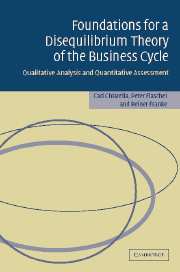 Foundations for a Disequilibrium Theory of the Business Cycle
Foundations for a Disequilibrium Theory of the Business Cycle Book contents
- Frontmatter
- Contents
- List of figures
- List of tables
- Foreword by J. Barkley Rosser, Jr.
- Preface
- Notation
- 1 Competing approaches to Keynesian macrodynamics
- Part I Textbook Approaches
- 2 AS-AD growth theory: a complete analysis of the textbook model
- 3 Disequilibrium growth: the point of departure
- Part II Analytical Framework: Theory and Evidence
- Part III Monetary Policy
- References
- Index
2 - AS-AD growth theory: a complete analysis of the textbook model
Published online by Cambridge University Press: 22 September 2009
- Frontmatter
- Contents
- List of figures
- List of tables
- Foreword by J. Barkley Rosser, Jr.
- Preface
- Notation
- 1 Competing approaches to Keynesian macrodynamics
- Part I Textbook Approaches
- 2 AS-AD growth theory: a complete analysis of the textbook model
- 3 Disequilibrium growth: the point of departure
- Part II Analytical Framework: Theory and Evidence
- Part III Monetary Policy
- References
- Index
Summary
Introduction
As indicated in the previous overview chapter, the hierarchy of disequilibrium growth theories discussed in this book starts with a supply-side model at a textbook level, which has originally been put forward by Sargent (1979, 1987, chap. 5). Being rooted in the neoclassical synthesis and conventional AS-AD growth theory, it is a prototype model that integrates into a consistent whole what has been – and still is – regarded by many economists as being representative of Keynesian macroeconomic theory. It can, in particular, be considered a first complete Keynesian model, insofar as it includes dynamic interactions between all three of the main market groups: the markets for goods and labour, and financial markets.
The model ensemble is impressive in its purposeful and parsimonious design. However, although the building blocks are most elementary, Sargent's subsequent investigation of the resulting dynamic system remains incomplete and inconclusive. Besides slightly extending Sargent's framework, the present chapter identifies what is missing in his treatment and sets out to provide a full analysis of the local dynamics of this model.
While the models in the chapters to follow are more demand-oriented and also, as we believe, in many respects more satisfactory, it is nevertheless useful to begin with a careful study of Sargent's contribution. The reason is that his system already exhibits a variety of properties that will later be encountered in our more advanced model variants as well.
- Type
- Chapter
- Information
- Foundations for a Disequilibrium Theory of the Business CycleQualitative Analysis and Quantitative Assessment, pp. 63 - 99Publisher: Cambridge University PressPrint publication year: 2005
